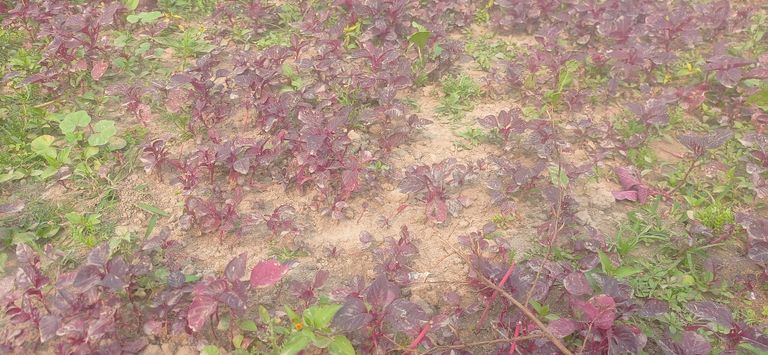Method of Cultivation of Red Spinach:
Climate and Soil Requirements:
Climate: Red spinach thrives in moderate climates, preferring cooler temperatures between 15-20°C (59-68°F). It can grow year-round in temperate regions.
Soil: Well-drained, fertile loamy soil with a pH between 6.0 and 7.5 is ideal for red spinach cultivation. It requires soil rich in organic matter to support healthy growth.
Seed Preparation and Sowing:
Seeds: Red spinach seeds should be purchased from a reputable source. Before sowing, the seeds can be soaked in water for 12–24 hours to improve germination.
Sowing: Plant seeds directly into the ground or in seed trays. Space seeds about 10-15 cm apart in rows, with each row spaced 30-45 cm apart. You can also sow them in a greenhouse if the weather is too harsh for direct outdoor sowing.
Transplanting:
When seedlings are 4-6 weeks old, they can be transplanted into the garden or raised beds. Ensure the plants have adequate spacing (15-20 cm between each) to allow for proper airflow and growth.
Watering and Irrigation:
Regular watering is essential, especially during dry periods. Red spinach prefers a consistently moist environment, but it should not be waterlogged. Drip irrigation is a good choice to maintain moisture levels.
Fertilization:
Apply a balanced organic fertilizer or compost before planting to enrich the soil. During the growing season, additional feeding with a liquid fertilizer can help boost growth, especially if the soil is nutrient-deficient.
Pest and Disease Management:
Keep an eye out for common pests like aphids and caterpillars, as well as fungal infections. Use organic pesticides or neem oil to address pest problems.
Regularly remove dead or yellowing leaves to prevent disease spread and promote better air circulation.
Harvesting:
Red spinach is ready for harvest about 30–45 days after sowing, depending on the growing conditions. You can harvest young leaves for tender greens or allow them to mature for larger, more robust leaves.
Harvest by cutting the leaves from the outer portions of the plant, leaving the center intact for further growth. This method encourages continued leaf production.
Nutritional Properties of Red Spinach:
Red spinach, also known as Amaranthus tricolor, is a highly nutritious leafy green vegetable. Below are some of its key nutritional properties:
Vitamins:
Vitamin A: Red spinach is an excellent source of vitamin A, which supports vision, skin health, and immune function.
Vitamin C: Rich in vitamin C, red spinach helps




strengthen the immune system, promotes wound healing, and acts as an antioxidant.
Vitamin K: A good source of vitamin K, which is essential for blood clotting and bone health.
Folate (Vitamin B9): Red spinach provides a significant amount of folate, important for DNA synthesis and cellular function.
Minerals:
Iron: Red spinach is rich in iron, helping to prevent anemia and improve the body's ability to transport oxygen.
Calcium: Contains calcium, which is crucial for bone and dental health.
Magnesium: Supports nerve function and regulates muscle and heart function.
Potassium: Helps maintain normal blood pressure and balance fluid levels in the body.




Fiber:
Red spinach is high in dietary fiber, which supports digestive health, reduces cholesterol levels, and helps manage blood sugar levels.
Antioxidants:
Red spinach is rich in antioxidants like polyphenols, flavonoids, and carotenoids (including beta-carotene), which help neutralize harmful free radicals in the body, reducing the risk of chronic diseases.





Low in Calories:
Red spinach is low in calories, making it an excellent choice for those looking to maintain or lose weight. It provides essential nutrients with minimal energy content.
Phytochemicals:
The presence of phytochemicals in red spinach, such as anthocyanins, which give the leaves their red color, have been linked to anti-inflammatory and anti-cancer properties.
Protein:
Red spinach contains a modest amount of plant-based protein, contributing to muscle repair and overall health.





Conclusion:
Red spinach is a nutrient-dense leafy green that is easy to grow and offers significant health benefits, including boosting immunity, supporting bone health, and aiding in digestion. Whether consumed raw in salads, cooked as a side dish, or used in soups, it is a versatile vegetable that enhances both taste and nutrition.

